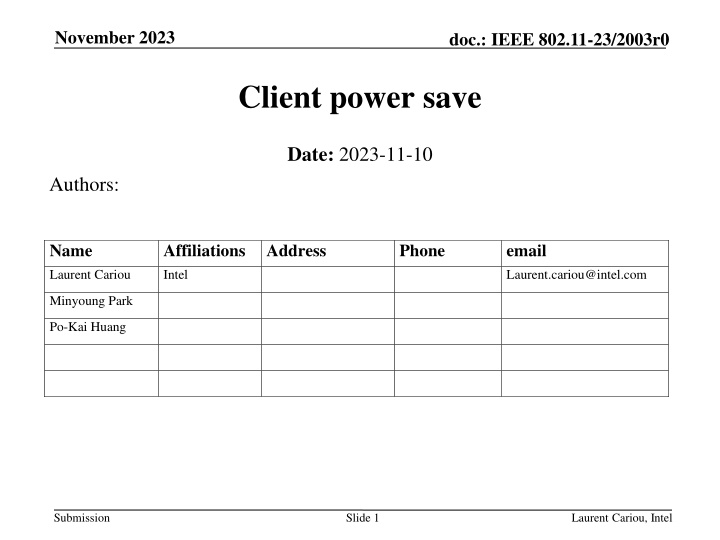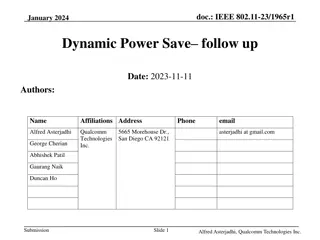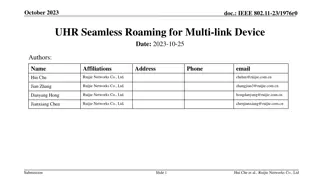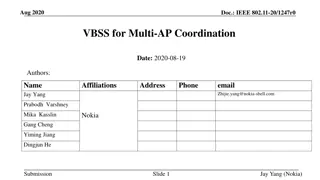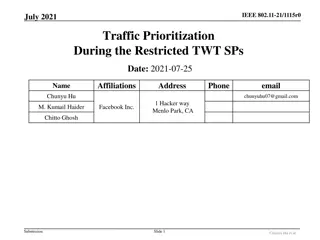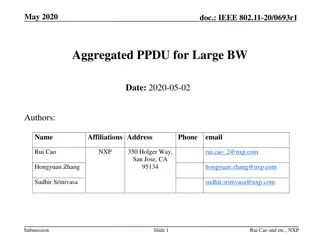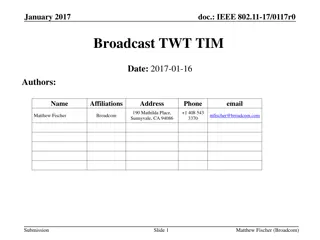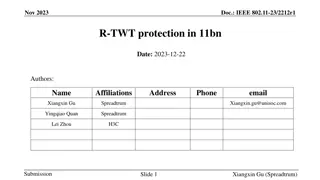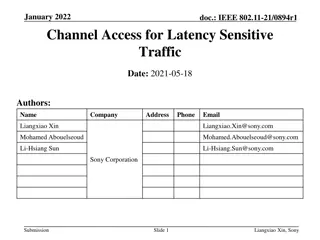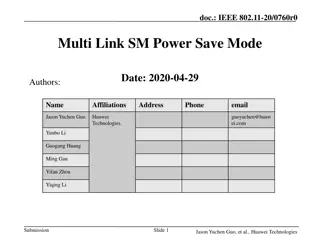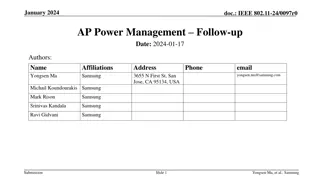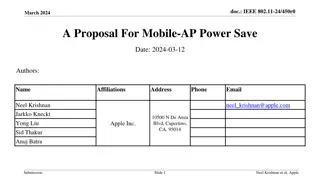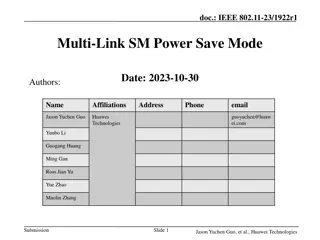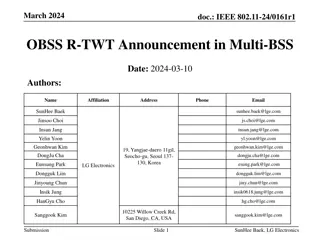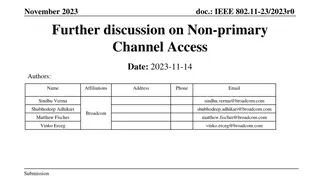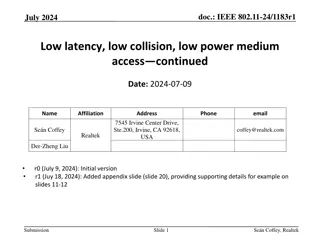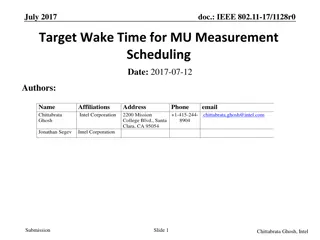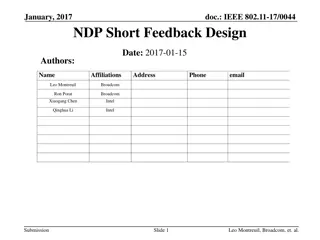Enhancing Power Save Mechanisms in IEEE 802.11 for Non-AP STAs
The document discusses improving power save mechanisms for non-AP STAs in IEEE 802.11 by focusing on reducing power consumption during listen mode, enhancing flexibility in transitions between power states, and proposing solutions to enable reception on smaller bandwidths. It emphasizes the importance of enabling STAs to change bandwidth efficiently to check clear channel assessment. The proposed solution involves adding an Intermediate FCS field to facilitate BW changes during the padding time, allowing CCA checks within the TxOP BW duration.
Download Presentation

Please find below an Image/Link to download the presentation.
The content on the website is provided AS IS for your information and personal use only. It may not be sold, licensed, or shared on other websites without obtaining consent from the author.If you encounter any issues during the download, it is possible that the publisher has removed the file from their server.
You are allowed to download the files provided on this website for personal or commercial use, subject to the condition that they are used lawfully. All files are the property of their respective owners.
The content on the website is provided AS IS for your information and personal use only. It may not be sold, licensed, or shared on other websites without obtaining consent from the author.
E N D
Presentation Transcript
November 2023 doc.: IEEE 802.11-23/2003r0 Client power save Date: 2023-11-10 Authors: Name Laurent Cariou Affiliations Intel Address Phone email Laurent.cariou@intel.com Minyoung Park Po-Kai Huang Submission Slide 1 Laurent Cariou, Intel
November 2023 doc.: IEEE 802.11-23/2003r0 Non-AP STA and non-AP MLD power save Always important to improve non-AP STA power save In 802.11 we have 2 power states: Doze and Awake But Awake state is evolving with eMLSR into 2 sub-states: Awake in listen mode (using SMPS or eMLSR) Awake in receive or transmit mode (full power) Overall: We see benefits to reduce further power consumption during listen mode We see less gains (less priority) for receive full power mode, but open to enhancements we see benefits to improve flexibility in transitions between Doze and Awake with MLO. Submission Slide 2 Laurent Cariou, Intel
November 2023 doc.: IEEE 802.11-23/2003r0 eMLSR Listen mode power consumption reduction STAs can stay for a long time in listen mode and should consume as little power as possible With eMLSR, STAs can already only enable reception of some low MCSs of a single NSS with a single antenna Current gap is to be able to only enable reception on 20MHz instead of the STA s operating BW, which would provide significant power gains This is theoretically possible with eMLSR, but there s currently no time after the ICF to reconfigure the radio to a larger bandwidth and to check CCA on the TxOP BW before responding with CTS Data ICF (e.g. MU-RTS) SIFS TxOP owner AP ICF response (e.g. CTS) TxOP responder STA 20MHz operation: listen mode 80MHz operation: power mode Transition from 20 to 80MHz Check CCA Submission Slide 3 Laurent Cariou, Intel
November 2023 doc.: IEEE 802.11-23/2003r0 Proposal We need to give more time for the STA to be able to change BW so that it can check CCA during SIFS between ICF and ICF response One could thing we can use padding, but actually the padding is included before the FCS in non-HT dup (which has to be used in that case), which forces the STA to wait until the end of the ICF PPDU before being able to switch We propose to add a new Intermediate FCS field (called here FCS2), before the padding so that the STA can use the padding time to change BW and use SIFS to check CCA on TxOP BW. We can exploit the trigger structure as follows: FCS calculated on whole data portion up to FCS2 User Info field Common info User info STA1 User info STA2 FCS2 User Info FCS2 User Info Padding User Info Padding User Info Frame control RA TA FCS Duration 20MHz operation: listen mode Transition from 20 to 80MHz 80MHz operation: power mode Note that this is the same issue and solution as for dynamic subchannel operation Submission Slide 4 Laurent Cariou, Intel
November 2023 doc.: IEEE 802.11-23/2003r0 More details on inclusion of FCS Define a special User Info field to include the intermediate FCS Just one intermediate FCS for all STAs that can exploit it Special User Info field using an AID12 value that is unique and defined in spec Otherwise, keep same frame structure Legacy STA will ignore this field and look for the FCS field at the end UHR STAs will be able to terminate processing of the ICF at the end of the intermediate FCS If we do trigger frame protection: Protection signaling needs to be included before this intermediate FCS Submission Slide 5 Laurent Cariou, Intel
November 2023 doc.: IEEE 802.11-23/2003r0 Allowing more flexibility in using eMLSR Power save on each link As discussed in previous slides, we see potential for some power save enhancements with eMLSR during the listen mode operation These benefits come from the TxOP sequence defined for eMLSR, which mandates inclusion of ICF/ICF response at the beginning of the TxOP, and includes padding for transitions between listen mode and full-power mode This TxOP sequence defined and used for eMLSR can be used as a power save mechanism on each link Single link eMLSR (where the eMLSR link set is made of a single link) is actually such a power save mode that applies at the link level. Same as SMPS (which is per link), but with additional power saving benefits and more widespread support Submission Slide 6 Laurent Cariou, Intel
November 2023 doc.: IEEE 802.11-23/2003r0 Per link eMLSR-like dynamic power save We propose to allow to use such TxOP sequence (ICF with padding/ICF response) on each link, even when eMLSR is not used on this link Ex: dual radio non-AP MLD: Can do eMLSR-like power save on each link (as an SMPS replacement to be able to transition from listen mode to full power mode on each link independently from the other links) We can define this by: Adapting SMPS so that it includes the TxOP sequence used for eMLSR (ICF with padding/ICF response) Allowing a non-AP MLD to negotiate multiple eMLSR agreements with the AP MLD and especially have multiple single link eMLSR agreements (fully reusing in this case the single link eMLSR concept as a replacement of SMPS) Define negotiation for a new per-link power save mechanism that uses the exact same sequence as eMLSR (ICF with padding/ICF response) Extract eMLSR TxOP sequence rules into a generic procedure that can evolve and be used by eMLSR across links and by this per-link power save mode at the link level. We could use that also for a mobile AP MLD, but need to analyse this to see if the gains envisioned are sufficient Submission Slide 7 Laurent Cariou, Intel
November 2023 doc.: IEEE 802.11-23/2003r0 Power save enhancements with MLO: Cross-link PS First priority for us regarding power save exploiting MLO dimension is to finally enable cross link power save: Allowing to indicate power save mode changes and/or power state changes from one link for the other Really lacking in current MLO framework If a non-AP MLD wants to go in doze state, it has to access medium on both links to change PM mode. Beneficial for all types of non-AP MLDs (eMLSR, multi-radio, ) Submission Slide 8 Laurent Cariou, Intel
November 2023 doc.: IEEE 802.11-23/2003r0 SP1 Do you agree to define a new special user info field that can be present in the eMLSR initial control frames (MU-RTS and BSRP Trigger frames) to include an additional and intermediate FCS field before the Padding field and the FCS field? Submission Slide 9 Laurent Cariou, Intel
November 2023 doc.: IEEE 802.11-23/2003r0 SP2 Do you support to define a power save mode for a non-AP STA where the STA may transition from a lower capability mode to a higher capability mode upon reception of an initial control frame? Submission Slide 10 Laurent Cariou, Intel
November 2023 doc.: IEEE 802.11-23/2003r0 SP3 Do you agree to define cross link power save signaling allowing a non-AP MLD to indicate to its associated AP MLD, in a frame sent on one enabled link, the power save mode changes and/or the power state changes for one or more of its affiliated non-AP STAs operating on other enabled links Submission Slide 11 Laurent Cariou, Intel
